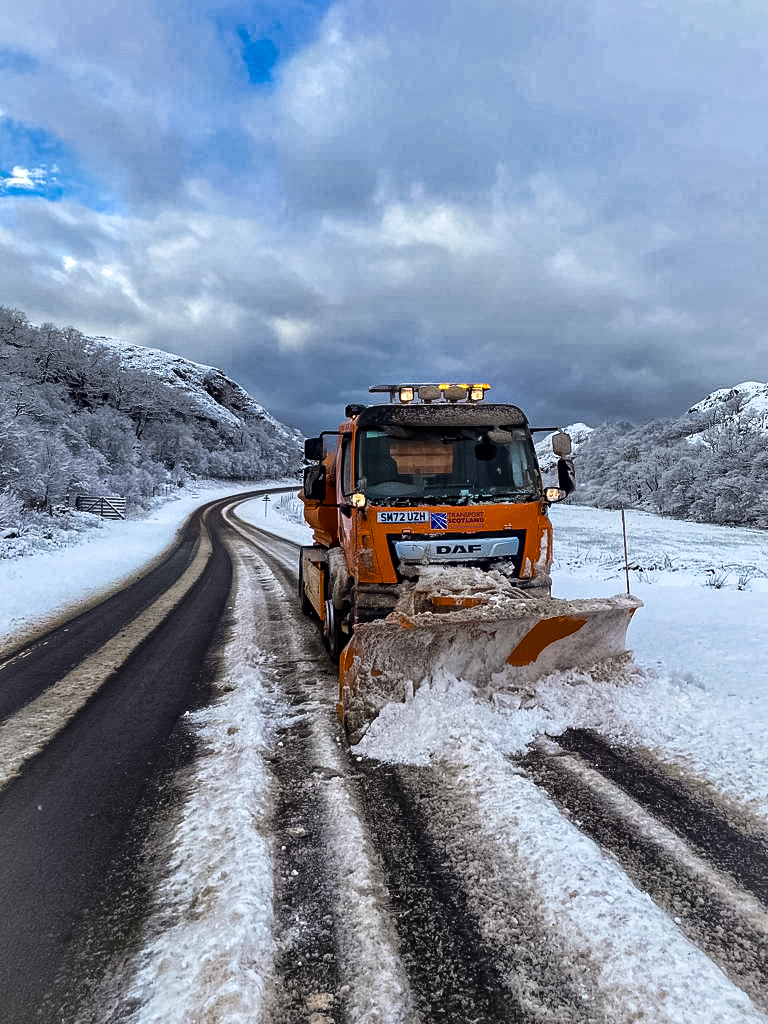
BEAR Scotland delivers winter maintenance as part of the North West and South East Trunk Road Units for on behalf of Transport Scotland. This involves clearing snow on some of the highest trunk roads in the UK, as well as treating roads ahead of frost and ice forming and salting footpaths. We also provide the winter service for M80 and A92 DBFO contracts.
Our teams work hard in difficult conditions to keep roads clear and safe to help keep Scotland moving, whatever the weather.
The winter period runs from 1 October to 15 May each year.
Our current winter fleet of over 110 vehicles is available 24/7 throughout the winter period, ranging from huge 32-tonne eight wheeler spreaders to fast-track tractors fitted with ploughs or snow blowers capable of shifting over 600 tonnes of snow in an hour
The fleet is operated by over 210 trained winter operatives. We have a dedicated weather forecaster for each of our units who are contracted to provide a forecast for each of our spreader routes by midday for the coming 24 hour period. The treatment plan for the day is then drawn up which proposes our planned actions for the afternoon and night ahead. Our control room and Winter Service Duty Officers then monitor conditions for the period and take appropriate action where necessary.

The main focus is to carry out precautionary treatments to prevent ice forming. Every day BEAR Scotland receives detailed weather forecasts which predict which roads are expected to experience below freezing conditions and at what time. To help stop ice forming, winter spreaders then treat the roads before the temperature drops. This is usually late afternoon (before peak traffic) and sometimes again overnight to make sure the roads have been treated before the morning peak. The spreaders used for precautionary treatments and patrols are equipped for pre-wetted salting. Pre-wetted salting uses brine mixed with dry salt immediately prior to spreading to help it stick to the road surface and start the melting process. During last year’s harsh winter BEAR Scotland used approximately 58,000 tonnes of de-icing materials across 8,200 treatments.
36 overnight winter patrols cover the North West and South East of Scotland, as well as the M80 DBFO and A92 DBFO. Winter patrol vehicles carry out reactive salt treatments and also record real-time road surface temperature data through on-board sensors which is fed to the 24/7 control room.

BEAR Scotland’s dedicated winter fleet includes:
To ensure plant is ready for the winter, dry runs are carried out on all precautionary treatment routes and calibration checks are undertaken on vehicles prior to 1 October.
Local primary schools and competition winners across the country help come up with names for some of BEAR Scotland’s spreaders, including:
North West:
M80 DBFO:
South East
A92 DBFO

The BEAR Scotland Control Rooms operate 24/7 and continuously monitors conditions across all the trunk roads BEAR Scotland is responsible for. The team help to monitor in real time the changes in temperature or weather conditions across the network, with the help of roadside weather stations across the network to help provide real-time, accurate information on conditions which is fed directly into the control room. The team can then arrange for additional gritters to reach any areas which require assistance should the weather takes a turn.

Remember:
Be prepared when travelling. Keep the following in your vehicle:
Check:

A road pavement has a natural life cycle and at some point it will require maintenance, repair and replacement. While most of these repair and replacement projects can be planned, sometimes a road surface can fail prematurely. Such failure can happen over the course of months, or it can be very sudden.

BEAR’s winter service runs from 1 Oct to 15 May with teams ready to tackle the Winter season 24/7. BEAR has over 210 operatives trained to tackle adverse weather conditions to keep the trunk roads we’re responsible for clear and safe for road users. Click the link below to learn all about our winter service and how we aim to keep Scotland moving.

On several occasions since the Queensferry Crossing opened to traffic, the bridge has been closed to traffic as a safety precaution after ice formed on the bridge’s towers and cables then fell onto the carriageway below. This occurred during a particular combination of weather conditions when wet snow blew in and stuck to the cables, froze and then fell off.
Our ability to forecast ice accretion has been enhanced following observations and measurements of the conditions that caused the issue in previous incidents. A bespoke system of weather sensors, thermal sensors, and thermal and optical cameras has been installed to monitor these conditions in real time.
Detailed operational procedures have been developed and tested to optimise the way we manage any similar incidents in future. An automated barrier system has been installed on both sides of the Queensferry Crossing that allows traffic to be diverted onto the Forth Road Bridge more quickly, should the Queensferry Crossing need to be closed for any reason.

Drivers can get winter driving advice at: https://www.traffic.gov.scot/winter-driving
Traffic Scotland provides real time information on trunk road conditions. You can visit access information at https://www.traffic.gov.scot/ or via twitter @TrafficScotland.
The Transport Scotland trunk road gritter tracker details where spreaders have been in the past 24 hours. This can be viewed online here: https://www.traffic.gov.scot/gritter-tracker
Further Winter Treatment information can be viewed at Traffic Scotland here: http://trafficscotland.org/wintergritterinfo/
Click here to view a copy of BEAR Scotland’s Winter Service Plan for the South East Unit.
Click here to view a copy of BEAR Scotland’s Winter Service Plan for the North West Unit.